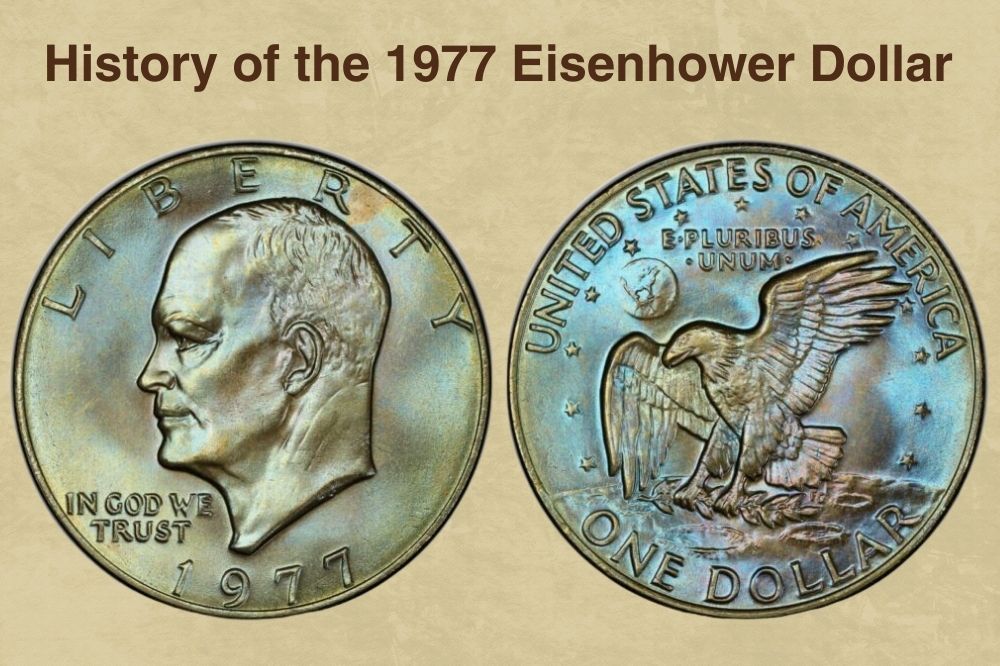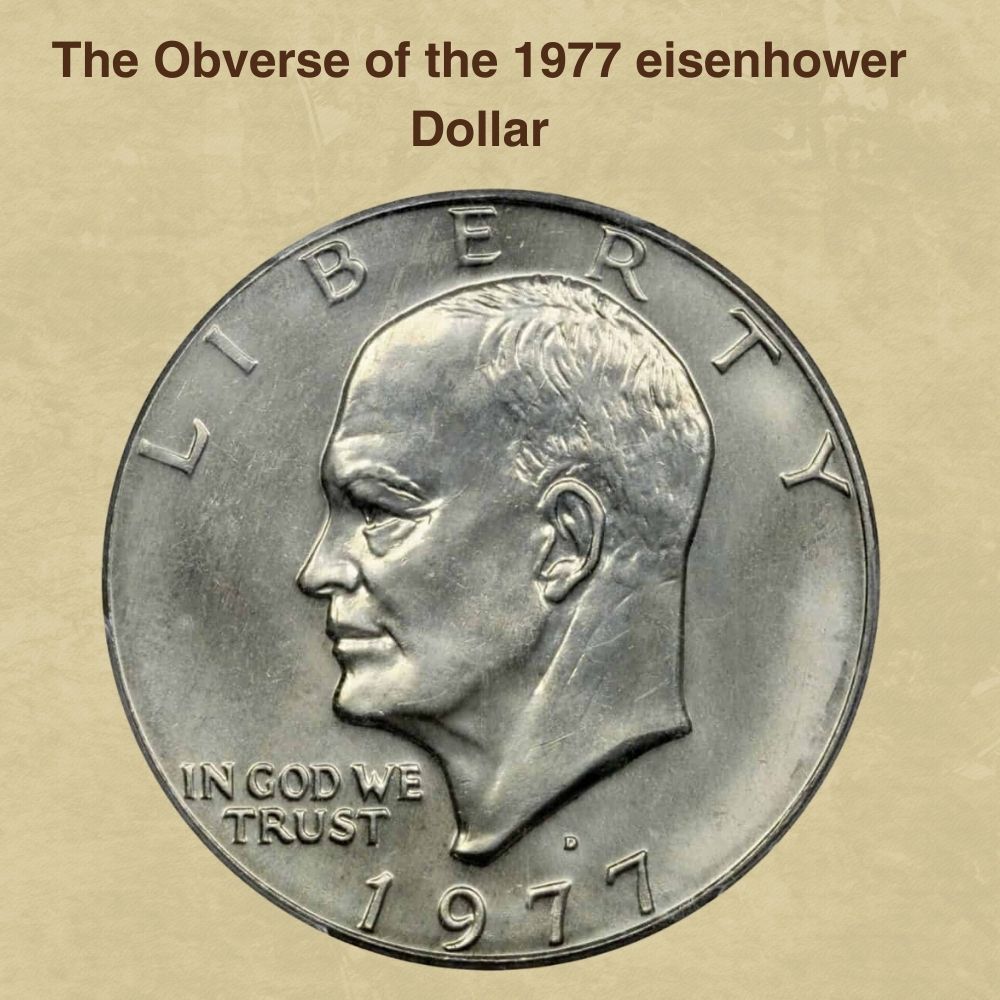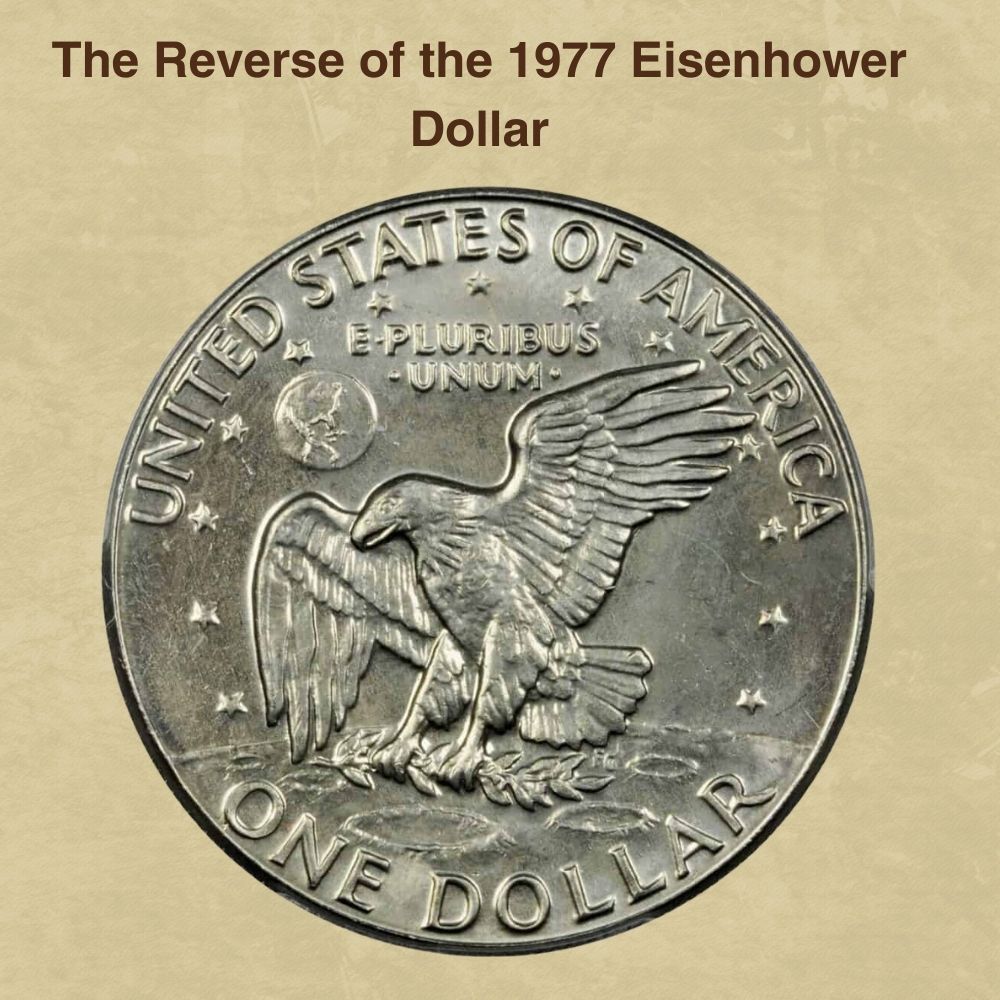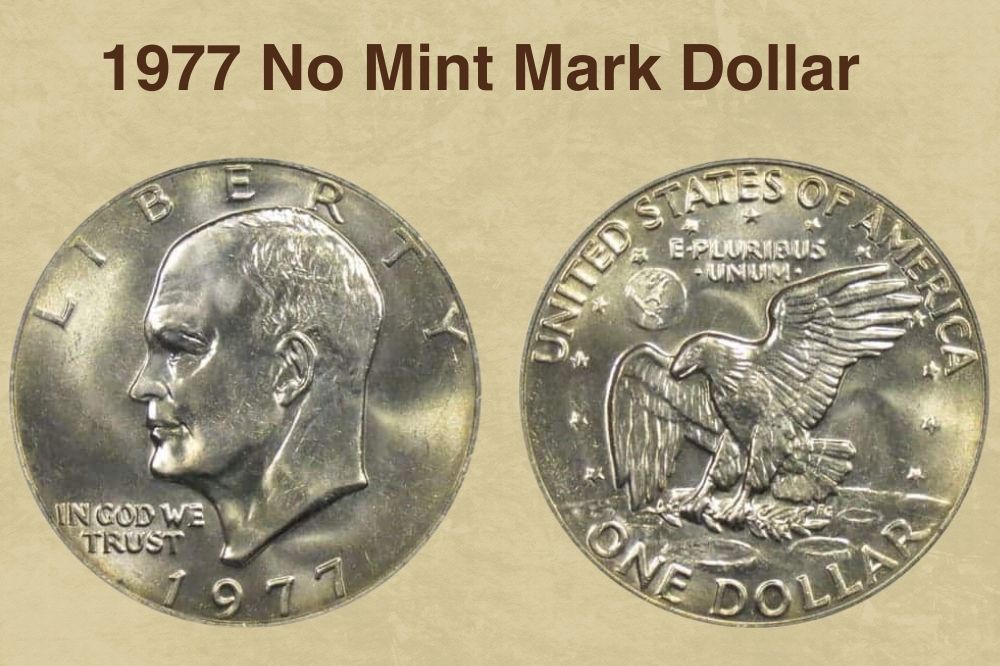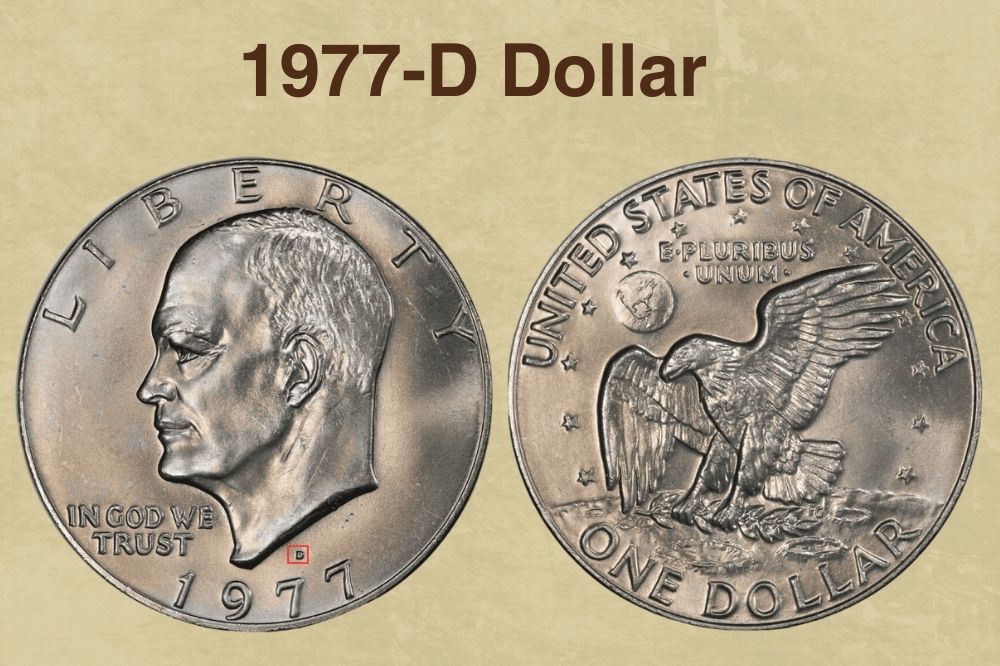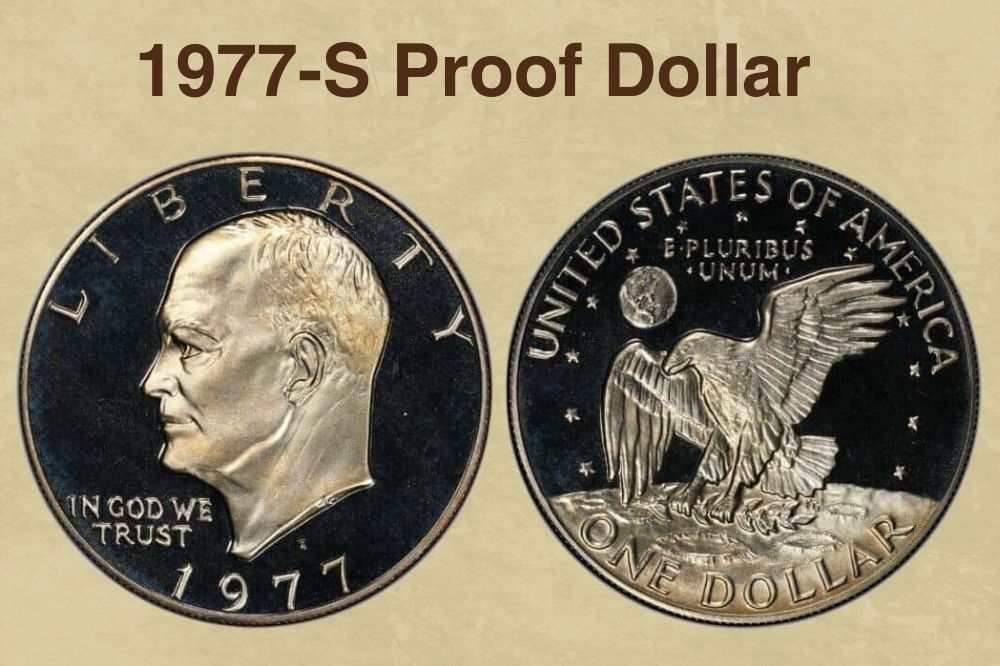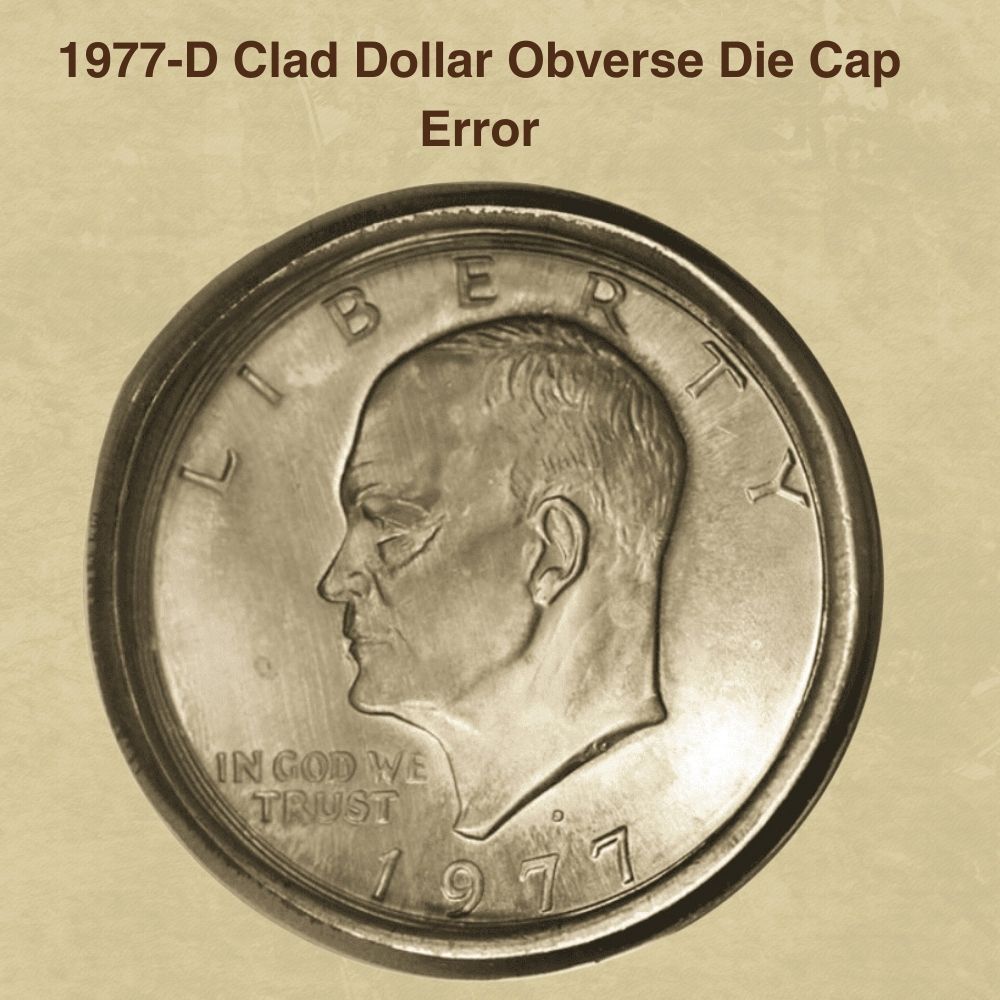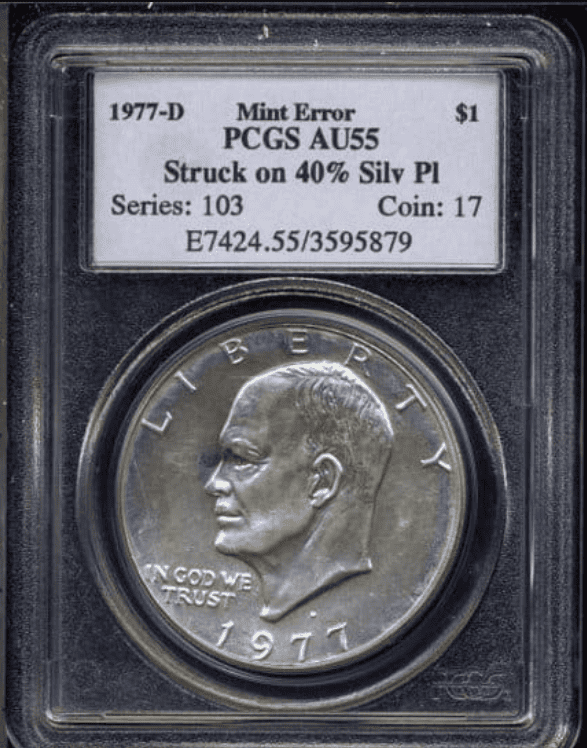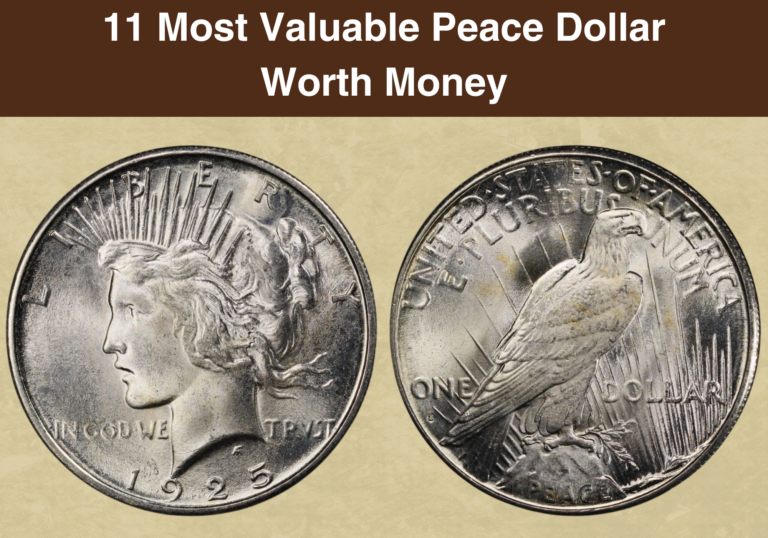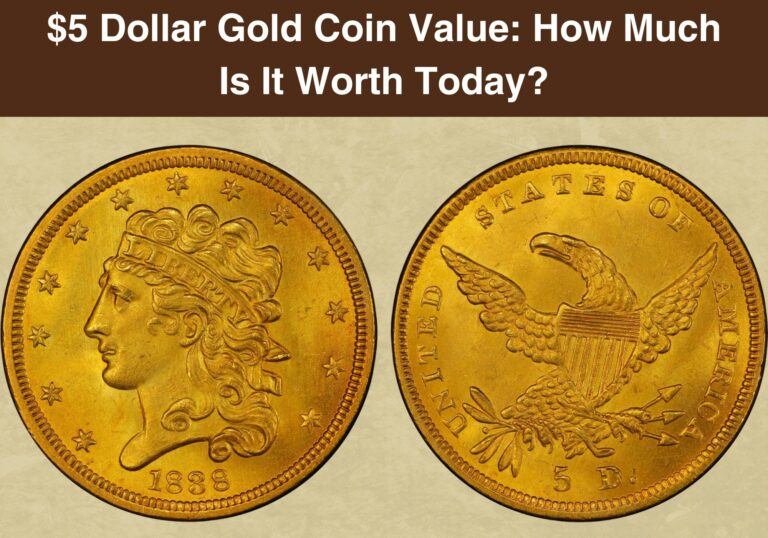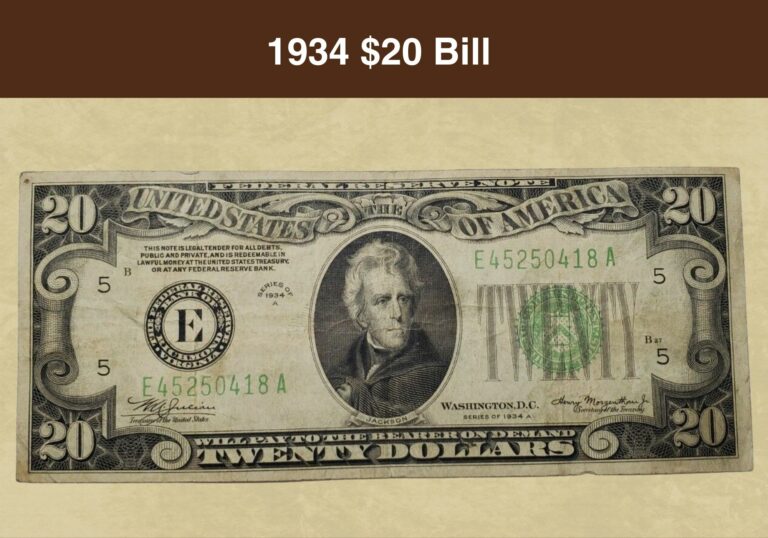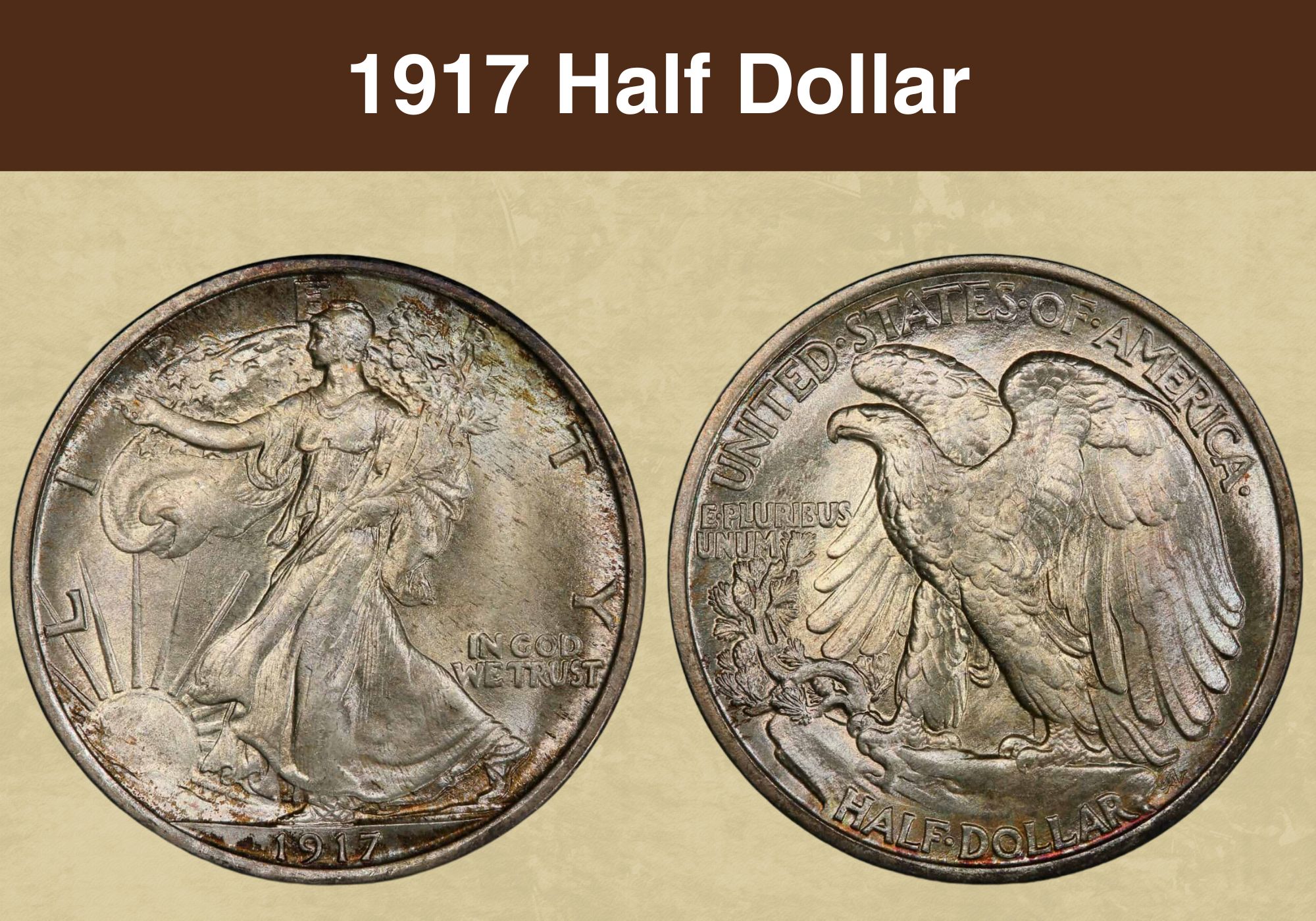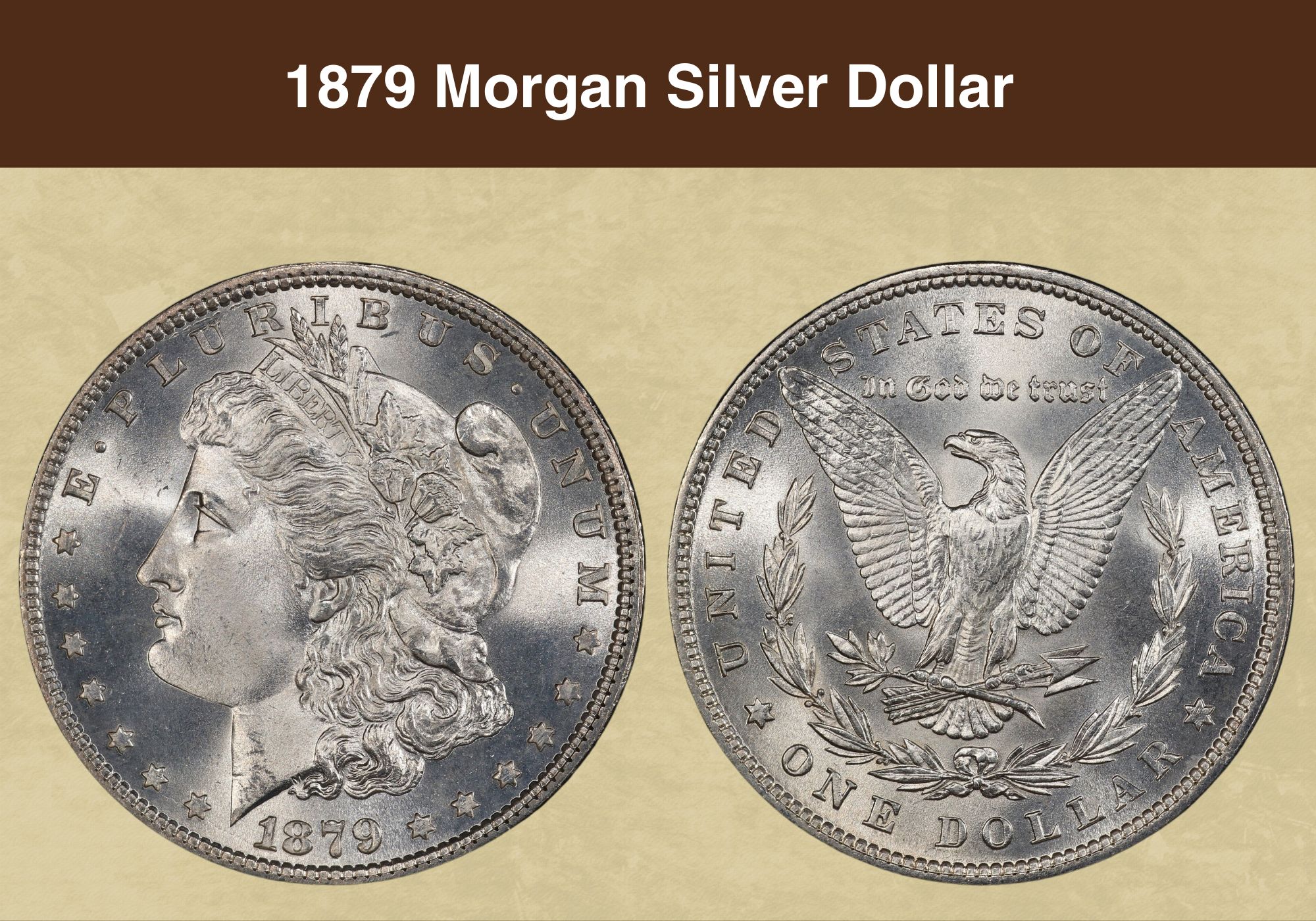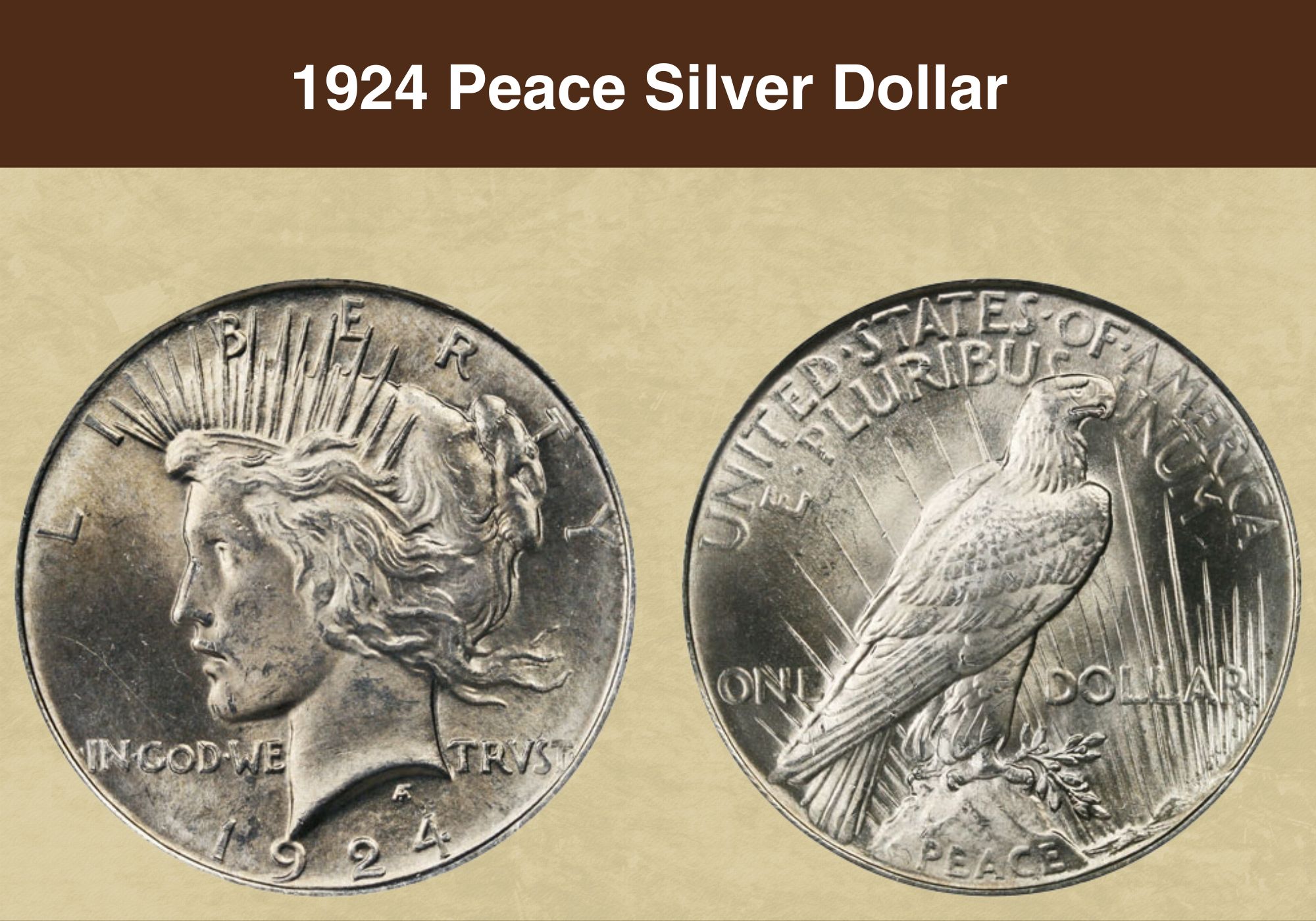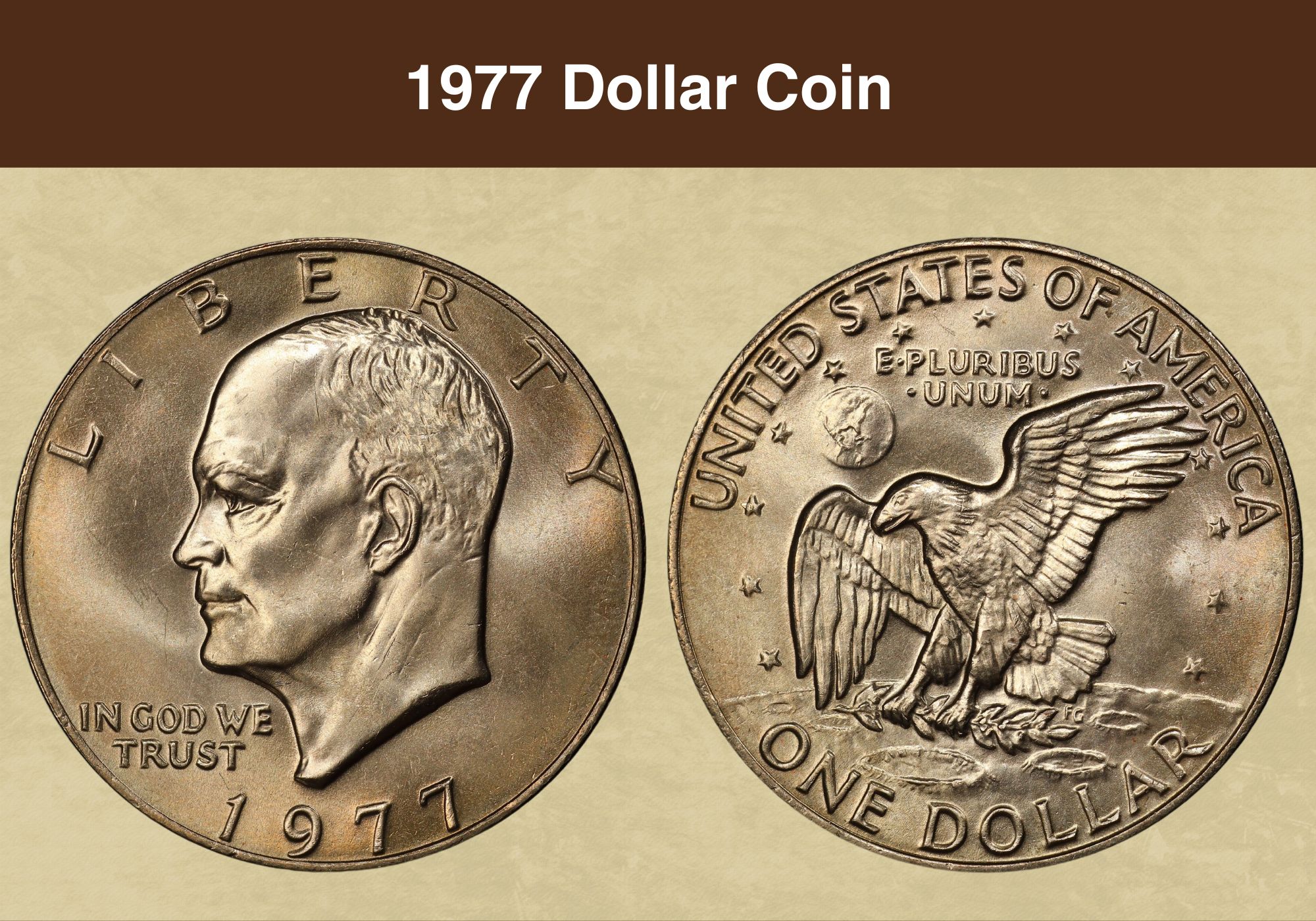
Coin Value Contents Table
- History of the 1977 Eisenhower Dollar
- Features of the 1977 eisenhower Dollar
- 1977 Dollar Value Guides
- 1977 No Mint Mark Dollar Value
- 1977-D Dollar Value
- 1977-S Proof Dollar Value
- 1977 eisenhower Dollar Grading
- Rare 1977 eisenhower Dollar Error List
- Where to Sell Your 1977 eisenhower dollar ?
- 1977 eisenhower Dollar FAQ
The 1977 Dollar coin was an Ike Dollar, named after Dwight Eisenhower, the 34th President of the United States. He was placed on the coin to honor his death in 1969. The coin also memorialized the Apollo 11 Moon Landing, which happened in 1969 as well. But this $1 coin didn’t leave the press until 1971. Let’s look into the true 1977 Dollar Value.
1977 Dollar Coin Value Chart |
|||||||
| Coin | Extremely/Extra Fine
EF/XF 45 |
Mint State
MS 60 |
Mint State
MS 65 |
Mint State
MS 66 |
Mint State
MS 67 |
Mint State
MS 68 |
Proof PF/PR 70 DCAM |
| 1977 (P) No Mint Mark Dollar | $1 | $5 | $37 | $110 | $1,850 | $27,500 | – |
| 1977-D Dollar | $1 | $5 | $36 | $160 | $4,850 | – | – |
| 1977-S Proof Dollar | – | – | – | – | – | – | $575 |
History of the 1977 Eisenhower Dollar
Before the invention of money, people often bartered goods and services. But it wasn’t easy to decide – for example – how many cows were worth a barrel of oil. Or how many eggs got you an ounce of beer. To ease the process, symbolic items like beads, shells, or special rocks were introduced. This transitioned to gemstones and standardized units of precious metals.
A metal coin was worth its weight, so a $1 gold coin had $1 worth of molten gold. This could get tricky when the spot price of the metal changed, making its face value (the denomination) worth less than its melt value. This explains why early American money was gold and silver with a bit of copper thrown in. But interestingly, the $1 silver and gold coins never took root.
The gold coins were small and easily lost, which was an issue since that was an entire day’s wage! And the silver coins were too bulky to lug around, especially since $1 bills aka silver certificates were so much more convenient. So the $1 coin became more of a prestige item for collectors and investors. The 1977 Dollar was a Clad Ike, the second-last year of the series.
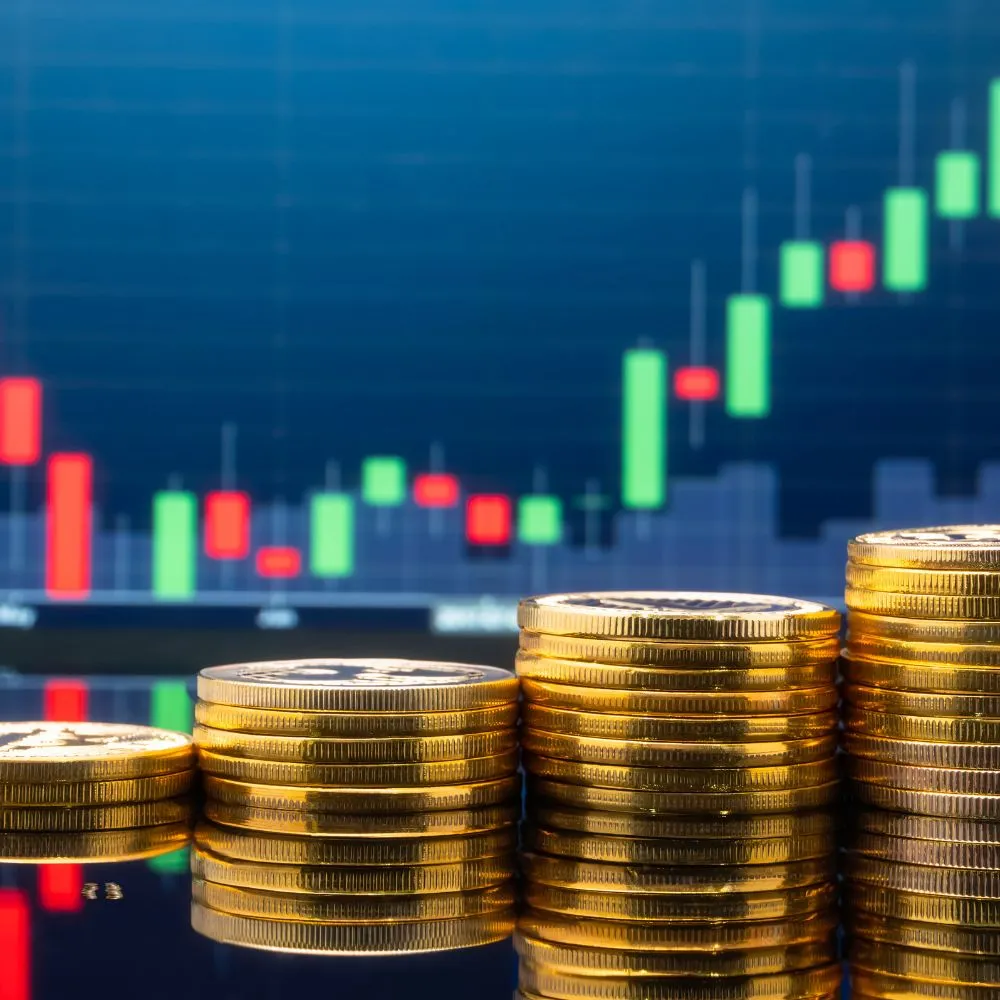
FREE Appraisal & Sell Your Coins
If you are still unsure about the price of your coins, you can appraise and sell your coins for free through our verified platform.
Honoring the 34th President
Ike Dollars, named for Dwight Eisenhower (who was better known as Ike) were minted to honor his death in 1969. But they weren’t released until 1971, due to various bureaucratic and political delays. They only lasted until 1978 when the mint tried to boost the use of $1 coins by shrinking them down to 1″. The Susan B. Anthony (SBA $1) launched this new idea.
As we noted earlier, fluctuating precious metal prices can affect coinage because it costs the mint more money to make them. And when melt value surpasses face value, the mint goes at a loss. This happened with silver in the 1960s, leading to coin hoarding and shortages. The mint gradually phased out silver coins in response, replacing them with cupronickel options.
The Ike Dollar was the last to go, and in 1977, they only made clad $1 coins. The outer layers still had a coat of nickel to mimic the earlier silver content, even though the coins were now base metal. Even the proof coins were cupronickel clad. But because they were still so bulky, 1977 Ike Dollars didn’t circulate much and ended up sitting in display cases and bank vaults.
The Secret Silver 1977 Dollar
While $1 coins were cupronickel clad in 1977, you’ll occasionally hear rumors of a 1977 Silver Dollar. What’s that about? Well, a few of the 1977 Dollars were inadvertently struck on silver-clad coins. These 40% silver blanks apparently dropped into the cupronickel-clad coin vats and got stamped amid their base metal cousins. From there, they slipped into the wild.
It’s not easy to identify these coins in circulation since they look like all the others. But if you find one and weigh it, you’ll realize it’s slightly heavier than normal. And if you check the side of the coin and closely inspect the reeds, you might notice there’s no copper bleeding through as expected on cupronickel dollars. These coins are rather rare so they get quite expensive.
But remember, as far as we know, this coin wasn’t deliberately minted. It was a mistaken strike and it wasn’t discovered until much later. Like all significant mint errors, it adds to the value of the coin, and you face the risk of finding fakes. So if you believe you have a 1977 Silver Dollar, consider sending it to PCGS or NGC for proper verification and assessment. And continue reading, we also record the 1977 silver dollar value below in coin error section.
Also read: 12 Most Valuable One-Dollar Coin Worth Money
Features of the 1977 eisenhower Dollar
Certain special terms are used to describe coin features. The heads side is the obverse and the tails side is the reverse. The thin side is the edge and its raised border is the collar or rim. Edges can be plain or reeded. Portraits and images are known as devices while the words are legends or mottos and the background is the field. Coins are struck on blank discs/planchets.
The Obverse of the 1977 eisenhower Dollar
It shows Ike Eisenhower facing left. The top of the coin says Liberty while the bottom has the mint date. In God We Trust is on the left, in front of his neck. The mint mark is on the right, above the last two digits of the date. The neckline cutoff has FG for designer Frank Gasparro.
The Reverse of the 1977 Eisenhower Dollar
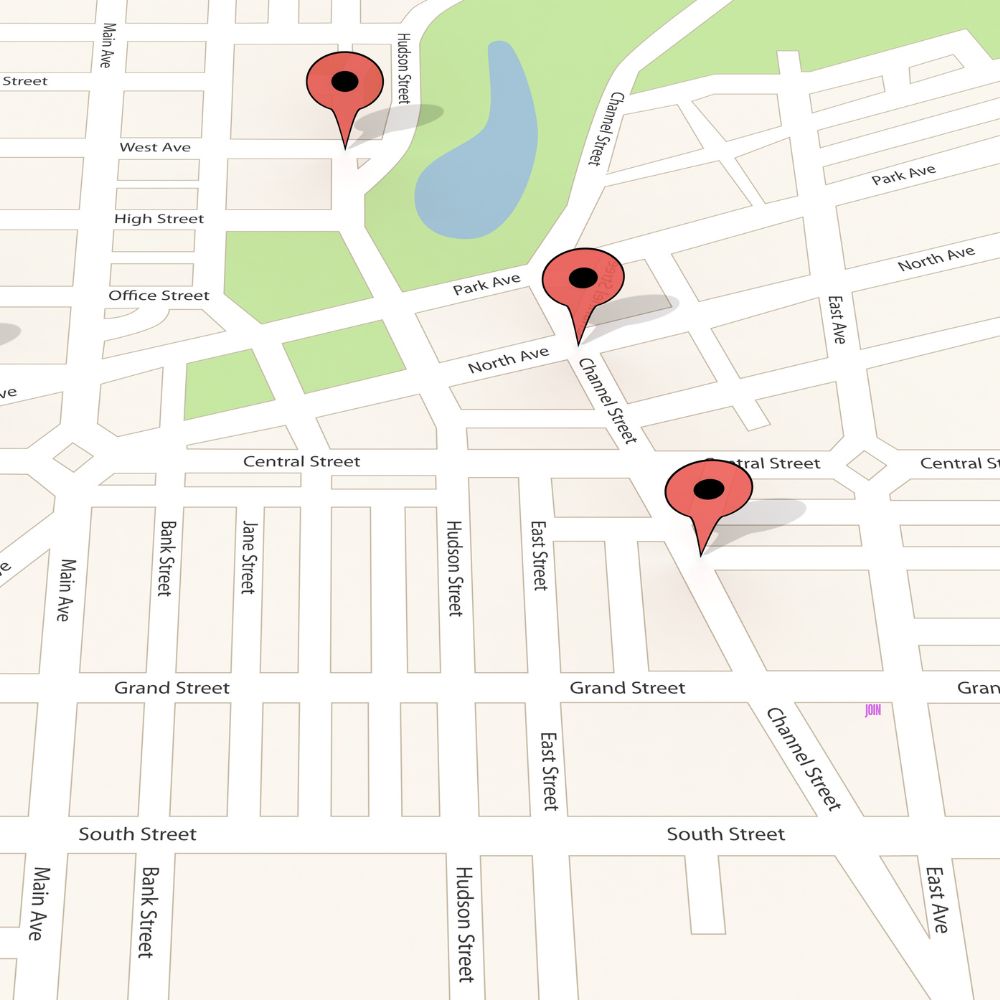
Best Coin Dealer Near Me
Want to Find the best coin dealer near you? Here we can help. (with customer reviews and Rating)
It shows an eagle with an olive branch landing on the moon. 13 stars surround the eagle and the Earth is above its head on the left. The top of the coin says United States of America with E Pluribus Unum below the stars. The bottom reads One Dollar. FG is under the eagle’s tail.
Other Features of the 1977 eisenhower Dollar
The reverse design was based on the Apollo 11 Mission Patch designed by astronaut Michael Collins and drafted by artist James Cooper. The coin was 91.67% copper and 8.33% nickel, comprising a copper core and clad coating. It’s 38.1mm across, 2.58mm thick, and 22.68g.
Also read: 14 Most Valuable Coins In Circulation
1977 Dollar Value Guides
The Ike Dollar was rather short-lived. It was only minted from 1971 to 1978. In the first six years of its existence, the San Francisco Mint made silver versions. But in 1977 and 1978, all the coins were cupronickel clad. The innards were pure copper while the top coats were 75% copper and 25% nickel to imitate the silver shine. Let’s review mintage figures and pricing.
1977 No Mint Mark Dollar Value
The Philadelphia Mint made 12,596,000 Clad Dollar coins in 1977. They had no mint marks. On 31st March 2021, an MS 67 sold for $3,600. PCGS has seen almost 50 of these, so their value in April 2024 is $1,850. PCGS has also received two coins graded MS 67+, which they estimate at $5,500; and one coin graded MS 68, which they’ve appraised at $27,500 in 2024.
1977-D Dollar Value
In 1977, the Denver Mint made 32,983,006 Clad Dollar coins with the D Mint Mark. On 3rd February 2014, an MS 63 sold for $12,925. Almost 125 coins exist in that grade today so their value is sadly down to a mere $24 in April 2024. But the highest known grade is MS 67, and since PCGS has received 15 of them, their April 2024 value is approximated at $4,850.
1977-S Proof Dollar Value
Starting in 1975, the San Francisco Mint mostly made proof coins. They use special dies that are scrubbed with horsehair to give them a mirrored surface. And from 1971, a computerized laser is used to frost the parts of the die that needed a textured finish. The blanks get extra treatment too. They’re tossed in a vat full of 6mm stainless steel beads that tumble them.
This process means proof coins have a mirror-like field and a frosted device, with frosting on the raised words and numbers too. Earlier, the frosting was done via acid pickling, and a bit of the texturing wore off every time the die struck. This made the first 50 to 100 coins Deep Cameos while the next hundred or so were Cameo coins. With computers, the quality lasted.
In 1977, this mint branch made 3,251,152 Clad Dollar coins with the S Mint Mark. On 1st April 2008, a PR 70 DCAM – the highest possible grade – sold for $7,015. But PCGS has seen almost 300 coins in that grade, so they’re only estimated at $575 in April 2024. A PR 68 DCAM is even cheaper at $21 because PCGS has received close to 700 coins in that grade.

FREE Appraisal & Sell Your Coins
If you are still unsure about the price of your coins, you can appraise and sell your coins for free through our verified platform.
Also read: Top 10 Most Valuable Morgan Silver Dollar Worth Money
1977 eisenhower Dollar Grading
Ike Dollars – whether they’re silver or clad – are graded on a scale of 1 to 70 with Poor (PO 1) as the lowest and Mint State (MS 70) being the highest. In some places, Uncirculated is used instead of Mint State, but in other places, Uncirculated means coins graded below 59 but are still in exemplary condition because they’ve never circulated. Proof coins are graded PR/PF.
Rare 1977 eisenhower Dollar Error List
Mint mistakes can happen at the hub stage, die stage, or coin stage. And doubling errors are common, but they differ by phase. For example, hub doubling (DDO, DDR, etc.) is when the die shifts between hub strikes and copies the mistake to all its coins. Conversely, a double strike is when the planchet dislodges between die strikes and causes overlapping patterns.
1977-D Clad Dollar Obverse Die Cap Error
An obverse die cap is when a blank gets stuck on the obverse die. It ends up blocking the coin below it so the reverse design doesn’t imprint on the planchet. As a result, one coin will have an imprinted heads side and an empty tails side. Meanwhile, the coin on the underside might have a stamped tails side and an empty heads side to match. This sample sold for $29,000!
1977-D Clad Dollar Struck on a 40% Silver Planchet
In 1976, Bicentennial Dollar coins were 40% Silver and 60% Copper, but in 1977 and 1978, all the coins were 91.67% copper and 8.33% nickel. Here, a 1977 Ike Dollar was accidentally struck on a 1976 blank. You can tell because it’s heavier, weighing 24.9g. About 15 of these error coins have been spotted so far. An MS 63 sold for $26,400 on 24th February 2022.
1977-S Clad Dollar DDO Error
As we mentioned above, DDO means doubled die error, sometimes called hub doubling. When the die moves between hub strikes, the second impression lands slightly to the left or right and creates a sort of double-vision effect. This flaw can then be transferred to hundreds or even thousands of coins before it’s caught and corrected. PF 67 Cameo is only worth $35.

Best Coin Dealer Near Me
Want to Find the best coin dealer near you? Here we can help. (with customer reviews and Rating)
Where to Sell Your 1977 eisenhower dollar ?
Now that you know the value of your coins, do you know where to sell those coins online easily? Don’t worry, I’ve compiled a list of these sites, including their introduction, pros, and cons.
Check out now: Best Places To Sell Coins Online (Pros & Cons)
1977 eisenhower Dollar FAQ
What is a 1977 Silver Dollar?
The 1977 Silver Dollar is an error coin that was accidentally struck on a 1976 blank. From 1971 to 1976, Silver Ike Dollars were only made in San Francisco and they were mostly proof coins. And in 1977 and 1978, none of the Ike Dollars were meant to be silver. But some of the 40% Silver-Clad blanks got shipped to Denver by mistake. As a result, 10 to 15 Silver-Clad 1977-D Ike Dollars were minted. Because they’re so rare, they can sell for over $25,000!
What Makes a 1977 Silver Dollar Rare?
Technically speaking, 1977 Silver Dollars don’t exist! The last year for Silver Dollars was 1976 when the US Mint made Bicentennial Dollars in 40% Silver. These coins had a double date (1776 – 1976) to mark the 200th Anniversary of American Independence. Then in 1977 and 1978, all dollar coins were cupronickel clad. Their metal composition was 91.67% copper and 8.33% nickel. However, a handful of error coins were struck on 40% Silver Planchets from 1976. So far, around 15 have been discovered. Prices range from $12,000 to $26,000.
Are 1977 Eisenhower Dollars Silver?
No, they’re not. As we explained above, Ike Dollars from 1977 and 1978 were cupronickel clad. The core of the coin was pure copper while the outer layers were 75% copper and 25% nickel, totaling 91.67% copper and 8.33% silver. The nickel allowed the coins to simulate silver pieces. Today, this mix is used on dimes (10c), quarters (25c), and Half Dollars (50c). That said, as we explained above, 15 of the 1977-D Eisenhower Dollars were struck in silver.

